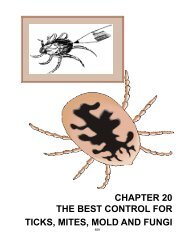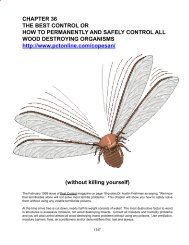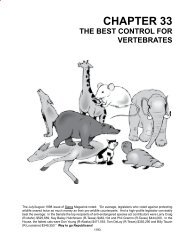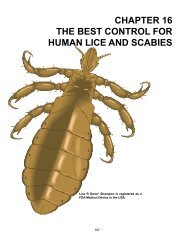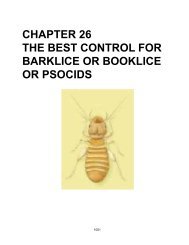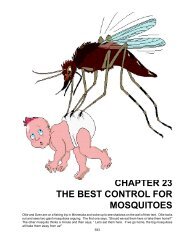viscous, dirty and/or sticky materials, lifting them off. Unregistered surfactants are used in pesticide poisonformulations, but we have found they work better alone, but then they become “unregistered pesticides”. Becausethe exoskeletal structures, wax and joints of insects are basically all comprised of hydrocarbon molecules,insects, gnats, mosquitoes, flies, etc. may avoid surfaces upon which diluted surfactants or (colloidal) micelleshave been sprayed for two days or more. When sprayed directly with surfactants, (which cause the micellation)insects, mites, mold, bacteria, etc. will all die quickly because of the lifting of hydrocarbon molecules (they literallyare dismantled)! Surfactants are considered to be biodegradable and basically innocuous to people and pets,but will often kill fleas, lice, spiders, ticks and other pests while washing or upon contact. If ingested, they maycause diarrhea primarily due to the emulsification of grease and oil in the digestive tract. A detergent buildercan simply be the second surfactant. Some natural surfactants are castile soap, yucca extract, soapwortand quillaja bark extract. <strong>The</strong> Author has found that blending simple surfactants can kill insects and arachnidsfaster and more safely and effectively than any synthetic pesticide ever could and the insects and arachnidscan not become resistant. One of the Author’s earlier formulas in 1997 was a cleaner that used 2.5% SLS, .5%Polysorbate 80 (polyoxyethylene sorbitan monooleate), 5% glycerin, 2% PEG, 1% peppermint oil, 2% sodiumborate and 1% protease. It was incredible and safe. Even greatly diluted this formula not only outcleans, butthis basic formula is very economical and easy to produce. Safe Solutions sells this formula as a basic cleaner.<strong>The</strong> use of various surfactant combinations, especially with variations of the Author’s many pestisafes ® , willundoubtedly be the pest control products of the future. If you need permission or help, call the Author — S.L.T.Surgery - Cut off all diseased and infested limbs and burn them. Remove the nest (eggs) and you remove thepest.Syrup - Use or put 1/2” of syrup into an (uncapped) old syrup bottle wherever you see “sweet” ants; when theyget into the syrup they can’t get out. When you no longer see any ants, cap the bottle and throw it away.Swags - Gather herbs such as pennyroyal, tansy, wormwood, peppermint, scented geraniums, tomatoes,southernwood, yarrow, lavender, and sage and arrange them in a swag secured with rubber bands - add a fewstems of cocks comb for color, wrap with ribbon to cover the rubber bands and hang upside down in your closet- your clothes, blankets, and towels will smell great and the bugs will stay away.Swallows - will “swallow” massive amounts of flying insects each day.Sweet Basil - Plant Ocymum basilicum in vegetable or flower gardens or chop and scatter the leaves to repelaphids, mosquitoes and mites. Sweet basil also acts as a fungisafe and slows the growth of milkweed bugs.Plant basil in a pot by a door to keep flies away. Basil will relieve the pain of insect stings and may be added toinsect repellent preparations. See Basil.Sweet Basil and Clove - will help repel flies.Sweet Peppers - <strong>The</strong> juice of sweet peppers will protect several plants from several viruses; while the juicesof sweet peppers and other succulent plants do not kill the viruses, they change the plants so they are notsusceptible.Sweet Flag, Calamus (Acorus calamus) - <strong>The</strong> alkaloid root works as contact poison to insects and is used inmothproofing, even though it is edible for humans. It grows commonly in swamps and along brooks.Synergism - Harmless levels of chemicals can become extremely toxic together.Synthetic Pesticide Poisons - “A worm in a jar of horseradish thinks its life is the sweetest of all,” JewishProverb. It is time to crawl out of the jar and experience other “flavors”; don’t be a shmendrik (fool) or a lemming...tryall of the Pestisafes ® or the other Intelligent Pest Management ® alternatives first! <strong>The</strong> application ofvolatile, synthetic pesticide poisons is the most common, useless and dangerous pest control method routinelyused in and around buildings, enclosed areas and vehicles. Pesticide poisons are used in a futile attempt toprovide chemical barriers to prevent insects from getting in. Synthetic poisons simply do not work. Mostpeople believe that if something is for sale - it is “safe”. Pesticide poisons are also routinely used to treat soil,wood, fabrics and other items in a vain attempt to prevent pest damage. <strong>The</strong> Author has proved over 90% oftheir use is “preventative” and need never be applied. Even when applied according to the label, synthetic464
pesticides have never controlled or eliminated all of the pests. <strong>The</strong> <strong>Best</strong> <strong>Control</strong> II © is better, safer and morepermanently done by caulking and screening and the use of IPM techniques. If you must use a (least-toxic)poison, use only boric acid, IGR’s, sodium borate, silica gels, insecticidal soaps, diatomaceous earth, neemsprays, and pyrethrin aerosols, but DO NOT USE any (even least toxic) synthetic pesticide poison until everysafer alternative has been attempted. <strong>The</strong> pest control “industry” has historically considered all volatile,synthetic pesticide poisons as the only real control tool they have available in spite of the fact they havenever really controlled any pests inside or outside using these volatile poisons. We now lose more ofour crops to insects than we did before pesticide poisons were used, only now we, the animals and earth arecontaminated. Historically the regulatory people have only been concerned if enough poison was applied...never if the toxins contaminated, or the poisons were misapplied or misused. We do not recommend their useexcept in rare circumstances and then only when all parties know all of the facts, dangers, risks and agreein writing. If you must use any pesticide poison, first carefully: choose the proper product, read labelscarefully before you buy and then use only as directed, and buy only what poison you need rather thandiscard the chemicals. Store poisons in their original containers with the labels intact and legible. If storedproperly, most pest control poisons will be effective the following season, so you don’t need to throw leftoverpoisons away. Tighten lids on liquid containers. Paper bags and boxes containing dust, granules or wettablepowders should be closed and resealed with tape. Dry products can also be stored, container and all, in a clean,sealable plastic bag. Lock pesticide poisons in a cabinet or storage room. This area should be separatefrom food supplies and protected form freezing temperatures or extreme heat. Dispose of pesticide poisonswith damaged containers. Never save empty containers. Check to see if your area has an authorizedmethod of pesticide disposal. Do not put empty containers in an outdoor trash receptacle. Make sureanimals and kids cannot get at these toxic containers. Carefully triple rinse, mutilate, puncture, and crush allcontainers and dispose of rinsate and containers properly. Wrap glass containers in newspaper beforediscarding. Do not burn any containers. We do not use these volatile toxins and we do not recommendtheir use! Synthetic pesticide poisons are also deliberate components of some clothing, shampoos,drugs, paints, wallpaper, shower curtains, rugs, blankets and mattresses - so even if someone is notroutinely spraying your area - you still may be routinely poisoned. True IPM or Intelligent Pest Management® should also attempt to remove all of these risks. Never use any volatile poisons!Syrphid Flies - a/k/a hover flies for their ability to hover in flight, are common predators of aphids and other softbodied insects. Adults are usually bee mimics. Three of the more common species are Syrphus rectus (OstenSacken), Allograpta obliqua (Say) and Eupeodes (formerly Metasyrphus) americanus (Weidemann). A. obliquamay complete development from egg to adult in less than 21 days. Various stages overwinter, depending onspecies, giving rise to adults in spring. Adults feed on pollen, nectar and aphid honeydew. Females must feedon pollen for proper egg maturation. Females oviposit in the midst of aphid colonies, using honeydew as anovipositional stimulant, and laying hundreds of eggs each. Eggs are often the first sign of aphid predators seenin the spring. Eggs are white, elliptical, and about 4/100 inch (1 mm) in length. <strong>The</strong>re are three larval instars.Larvae are elongate, tapering gradually toward the head end. Larvae search for prey by casting the forward endfrom side to side; prey must be contacted directly to be detected. Larvae pierce aphids with their mouth hooks,sucking fluids from the bodies before moving to other prey. Each larva may consume hundreds of aphids duringits development. Larval feeding success influences future fecundity. Third instar larvae have the greatestimpact on aphid numbers. Larvae of some species are relatively plump. <strong>The</strong>re may be 5 - 7 generations peryear. Multivoltine species overwinter as adults, univoltine species as third instar larvae. <strong>The</strong>se are among themost voracious of aphid predators.Tachnid Flies - Females lay eggs on the bodies of the host insect or on plants to be ingested by the host. <strong>The</strong>larvae or maggots mature inside the host, feeding on and eventually killing it. <strong>The</strong>y resemble houseflies, butusually are mottled rather than brightly colored. <strong>The</strong>re are hundreds of tachnid fly species in North America thatare terrific against caterpillars. <strong>The</strong>y can be attracted by tansy, spearmint or dill plantings.Tadpoles - and algae-eating fish and snails are very effective algae consumers.Tagamet ® - Add a little diluted Tagamet and some aspartame and/or acetaminophen to your baits to make themmore effective killers.Talcum Powder and/or Medicated Body Powders - <strong>Control</strong> and/or repel many pests when sprinkled around.Some people consider talcum powder to be carcinogenic and/or dangerous, but, given the opportunity to choose465
- Page 1:
CHAPTER 11SAFE AND FAR MOREEFFECTIV
- Page 4 and 5:
pesticide poisons do - to them the
- Page 6 and 7:
American Beautyberry (Callicarpa am
- Page 8 and 9:
packets in 4 days or less. Aspartam
- Page 10 and 11:
Baking Soda - Baking soda or sodium
- Page 13 and 14:
Bioderivatives - are substances whi
- Page 15 and 16:
Bird feeders - will attract more th
- Page 17 and 18:
an abrasive action on the insect wh
- Page 19 and 20:
pathogens - volatiles produced duri
- Page 21 and 22:
ground, grain and stored product ap
- Page 23 and 24:
epels many insects, including flies
- Page 25 and 26:
een used medically since at least t
- Page 27 and 28:
Collateral Damage - When you spray
- Page 29 and 30:
Cottonseed Meal - is a source of ni
- Page 31 and 32:
Desiccants - Hot air, dehumidifiers
- Page 33 and 34:
Dogs - have been trained to sniff o
- Page 35 and 36:
elderberry leaves to protect them f
- Page 37 and 38:
controls pests and acts as a deodor
- Page 39 and 40:
contamination that no one can hones
- Page 41 and 42:
Chlorphyll Graphite Parrafin wax Wa
- Page 43 and 44:
Film Capsule - The plastic capsule
- Page 45 and 46:
Repel roaches with bay leaves and e
- Page 47 and 48:
person in your house, but you’ll
- Page 49 and 50:
slender sickle-shaped jaws. They ap
- Page 51 and 52:
epellent that contains only natural
- Page 53 and 54:
infusion of pignut leaves, rubbed o
- Page 55 and 56:
Human Hair - cut in small pieces wi
- Page 57 and 58:
Insect Diseases - In 1836, Agostino
- Page 59 and 60:
Irrigation Management - Improper ir
- Page 61 and 62:
lack cutworms.Laxatives - Chocolate
- Page 63 and 64: we die. Check out magnesium in Chap
- Page 65 and 66: Milk Thistle - is a proven detoxifi
- Page 67 and 68: Moon Flower (Datura ioxia) - Do not
- Page 69 and 70: Spotted knapweed begins producing c
- Page 71 and 72: Nothing - Doing nothing is a choice
- Page 73 and 74: fertilizers and sprays will normall
- Page 75 and 76: added to enzyme cleaners or when us
- Page 77 and 78: yellow to yellow crystalline solid
- Page 79 and 80: Aureolaria virginica (L.) Pennell.
- Page 81 and 82: Clematis vitalba L. (Honduras fish
- Page 83 and 84: Euphorbia bicolor Engelm. and Gray.
- Page 85 and 86: Justicia adhatoda L. (Adhatoda vasi
- Page 87 and 88: Momordica charantis L. (Balsam-pear
- Page 89 and 90: Piper nigrum L. (Black pepper).Stro
- Page 91 and 92: Sesamum indicum L. (S. orientale L.
- Page 93 and 94: Xanthorrhoea hastilis R. Br. (Black
- Page 95 and 96: Pomander - Repel moths and other in
- Page 97 and 98: y Safe Solutions at 1-888-443-8738
- Page 99 and 100: ight red and cover them with petrol
- Page 101 and 102: a wide variety of antioxidants call
- Page 103 and 104: Sawdust - Sawdust can be treated wi
- Page 105 and 106: lit charcoal in the tunnels would a
- Page 107 and 108: Active IngredientGeneric Name Trade
- Page 109 and 110: Sour Milk - sprays will loosen scal
- Page 111 and 112: Stay Calm - Take a deep breath amd
- Page 113: to make the mix about the consisten
- Page 117: Temperature - Increase or lower tem
- Page 120 and 121: in colder climates. The most fragra
- Page 122 and 123: and/or dehumidifiers, plumbing and
- Page 124 and 125: odents, scorpions, etc. to your bai
- Page 126 and 127: Oregano also contains four anti-ast
- Page 128 and 129: like colds, and headaches and spend
- Page 130 and 131: then estimated human population. Gi
- Page 132 and 133: “The choice, after all, is ours t
- Page 134: 484



